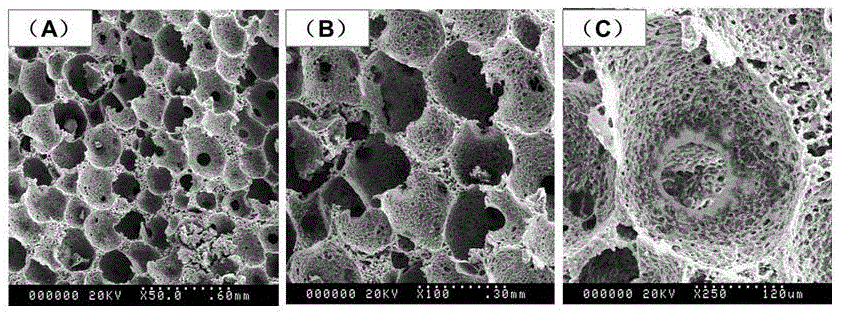A kind of 3D uniform porous scaffold material and preparation method thereof
A porous scaffold and uniform technology, applied in the field of biomedical materials, can solve the problems of high pore size, unfavorable vascularization, affecting cell-cell communication, etc., and achieve the effect of high porosity, good compressive strength, and improved mechanical strength
- Summary
- Abstract
- Description
- Claims
- Application Information
AI Technical Summary
Problems solved by technology
Method used
Image
Examples
preparation example Construction
[0032] A method for preparing a 3D uniform porous scaffold material, characterized in that:
[0033] Achieved by the following steps:
[0034] Step 1: Dissolving collagen in sodium carbonate solution so that the final mass fraction of collagen reaches 10-30%;
[0035] Step 2: Add nano-hydroxyapatite to the mixture in step 1, the mass ratio of collagen to nano-hydroxyapatite is 1: (3-5), shake on the vortex mixer until the mixture is uniform, and the viscosity is uniform like emulsion;
[0036] Step 3: distributing the mixture obtained in step 2 into moulds;
[0037] Step 4: The mold is frozen at -80°C for 3-6 hours, and then vacuum-dried for 48 hours;
[0038] Step 5: Carry out the cross-linking reaction of the primary freeze-dried bone scaffold material in step 4 in an excess of cross-linking agent solution. 100ml of cross-linking agent solution corresponds to 12-15g of the primary freeze-dried bone scaffold material. The pH of the system is adjusted to 8-11, the reaction...
Embodiment 1
[0050] Step 1: dissolving collagen in sodium carbonate solution so that the final mass fraction of collagen reaches 10%;
[0051] Step 2: Add nano-hydroxyapatite to the mixture in step 1. The mass ratio of collagen to nano-hydroxyapatite is 1:3. Shake on a vortex mixer until evenly mixed to obtain a viscous and uniform emulsion ;
[0052] Step 3: distributing the mixture obtained in step 2 into moulds;
[0053] Step 4: The mold is frozen at -80°C for 3 hours, and then vacuum-dried for 48 hours;
[0054] Step 5: Carry out the cross-linking reaction of the primary freeze-dried bone scaffold material in step 4 in an excessive amount of cross-linking agent solution, 100ml of cross-linking agent solution corresponds to 12g of the primary freeze-dried bone scaffold material, and use a pH regulator to adjust the pH value of the cross-linking system. The pH was adjusted to 8, the reaction temperature was 37°C, and the reaction time was 24h;
[0055] Step 6: Perform a secondary cros...
Embodiment 2
[0066] Step 1: dissolving collagen in sodium carbonate solution so that the final mass fraction of collagen reaches 20%;
[0067] Step 2: Add nano-hydroxyapatite to the mixture in step 1. The mass ratio of collagen to nano-hydroxyapatite is 1:4. Shake on a vortex mixer until evenly mixed to obtain a viscous and uniform emulsion ;
[0068] Step 3: distributing the mixture obtained in step 2 into moulds;
[0069] Step 4: The mold is frozen at -80°C for 4.5 hours, and then vacuum-dried for 48 hours;
[0070] Step 5: Carry out the cross-linking reaction of the primary freeze-dried bone scaffold material in step 4 in an excess cross-linking agent solution. 100ml of cross-linking agent solution corresponds to 13g of the primary freeze-dried bone scaffold material. The pH is adjusted to 9, the reaction temperature is 48°C, and the reaction time is 30h;
[0071] Step 6: Perform a secondary cross-linking reaction on the sample cross-linked in step 5 in an excess of cross-linking age...
PUM
 Login to View More
Login to View More Abstract
Description
Claims
Application Information
 Login to View More
Login to View More - R&D Engineer
- R&D Manager
- IP Professional
- Industry Leading Data Capabilities
- Powerful AI technology
- Patent DNA Extraction
Browse by: Latest US Patents, China's latest patents, Technical Efficacy Thesaurus, Application Domain, Technology Topic, Popular Technical Reports.
© 2024 PatSnap. All rights reserved.Legal|Privacy policy|Modern Slavery Act Transparency Statement|Sitemap|About US| Contact US: help@patsnap.com










